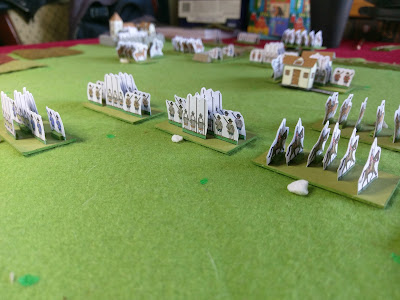Enthused by my refights of Whalley last week I decided to play another Portable Wargame this afternoon. After a few minutes with Google I came across this scenario for the 1644 Relief of Newark, and set about adapting it. Since I only have an 8x8 grid I decided to ruthlessly bathtub it, running each brigade as a single unit.
Here's the Parliamentarian besiegers: two bases of Trained Gallopers flanking two units of Pike & Shot, one Poor (in the cover of the Spittal) and one Trained (in the open, although the scenario did have parts of it in earthworks). In the distance you can see the siege artillery.
The Royalists started with two units on table, both Galloper units, one Elite (and led by Prince Rupert) and the other Trained.
The siege artillery face the Newark garrison, a unit of Poor Pike and Shot. They could sally forth on or after the turn on which the Royalist reinforcements arrived. I made their defences impregnable for game purposes.
The Royalists also had two units of Pike and Shot at the start, who arrived on the first turn, one Elite and the other Poor.
The battle stated with horse engaging on the Royalist right, Loughborough's Royalists against Lassiter's Parliamentarians. They would shove each other back and forth for most of the rest of the battle.
The Royalist foot advanced in the centre, and whilst the Norfolk Brigade stayed in the cover of The Spittal, King's Brigade moved forward to engage them.
Undocumented by the woodcut artist, Rupert's horse had driven forward against Thornhaugh's brigade of horse, and pushed them back almost to the walls of Newark.
Parliament rushed reinforcements to the battle, crossing the Trent via a bridge that was made of boats in the actual battle, but which wasn't in this refight.
Both sides had two units of reinforcements. Parliament had some Trained Trotters and Poor Pike and Shot, whist the Royalists had some Poor Gallopers and Poor Pike and Shot. At the start of each turn I rolled two D6 for each side and took the highest score. If it was equal to or less than the current turn, then that side's reinforcements would arrive.
The Royalists, now outnumbered but on the offensive, regrouped.
An overview of the battle. In the distance Rupert was still making heavy weather of the Parliamentarian horse.
Rupert fell back and led his troops in an attack on the Parliamentarian siege battery, destroying some of the guns.
He was drive off by the reinforcing horse, however, and quickly found himself outnumbered and surrounded when the other brigade of Parliamentarian horse joined in.
The newly arrived Parliamentarian foot also swung things in their side's favour, turning the Royalist left, undefended whilst Rupert was off elsewhere.
Rupert's horse were scattered, but the sight of Royalist reinforcements arriving emboldened the Newark garrison, who sallied forth and engaged Thornhaugh's brigade.
The arrival of the Royalist reinforcements allowed them to stabilise their position and push forward against the Parliamentarian centre.
The Newark garrison found itself beset by more horse, and seemed unequal to the task of inflicting any actual damage on either of its opponents.
The reinforcing Royalist horse, Porter's Brigade, came to the rescue but Parliament held. Another charge scattered the Newark garrison, the survivors fleeing back into the town.
Parliaments horse gained the upper hand on the other flank as well, routing Loughborough's horse. This halted the Royalist attack
A final Royalist volley saw off Parnham's Brigade, but the Royalists had failed to raise the siege and, with the garrison badly mauled, it would not be long before Parliament took Newark.
This was a more interesting game than I initially thought it would be, although on the open battlefield the rather free and easy flanking rules that the Portable Wargame has, combined with the low unit density, made flank attacks easier than perhaps they should be. Once again I used the quality system where poor units took one fewer hit and elite one more, whilst all units could convert a hit to a retreat if they rolled a 4+ and had an escape. The game really swung on the arrival of reinforcements; Parliaments' turned up two turns before those of the Royalists, allowing them to halt the Royalist attack before it had properly developed. By the time the Royalist reinforcements turned up, Parliament's position was relatively stable, and their low losses (a unit of horse and one of foot) reflected this.
Once again, though, the Portable Wargame delivered a fun game with minimal effort.




















A question, since there are no grids or areas on the table, how were unit movements and shots made possible ?
ReplyDeleteThere is a grid. If you look closely at the pictures you can see green dots on the cloth. Those mark the corners of the squares.
DeleteOK, now I saw them, they were perfectly camouflaged with the cloth ;-)
DeleteWonderful looking game.
ReplyDeleteyou r great bro!!! :D but i prefer the grid map... did you not try it?
ReplyDeleteThe game is played on a grid. See those green dots on the cloth? They mark the corners of the squares.
Delete